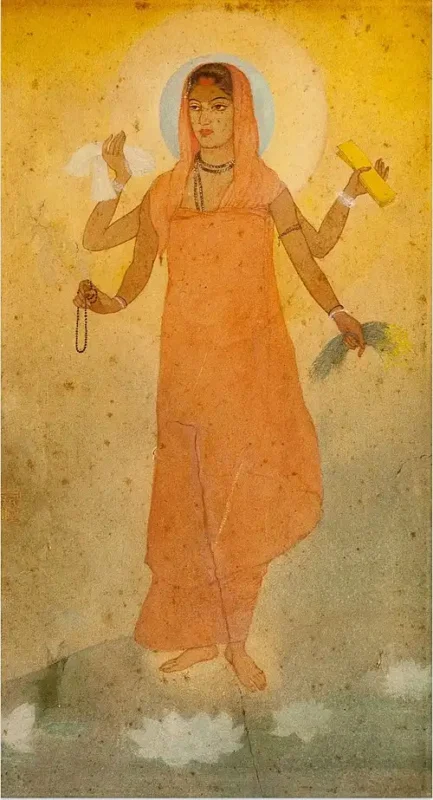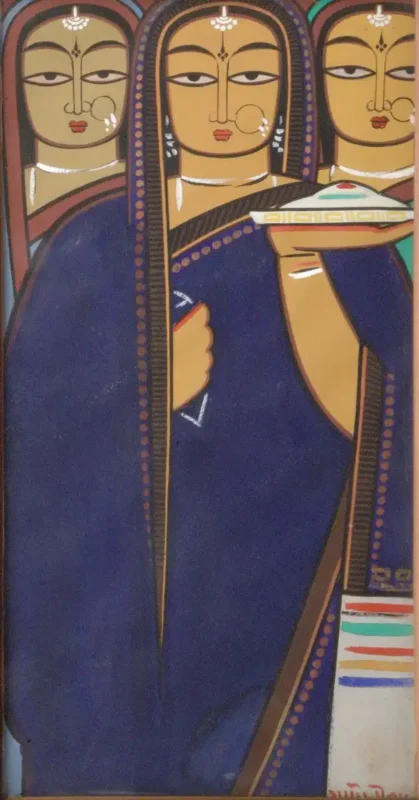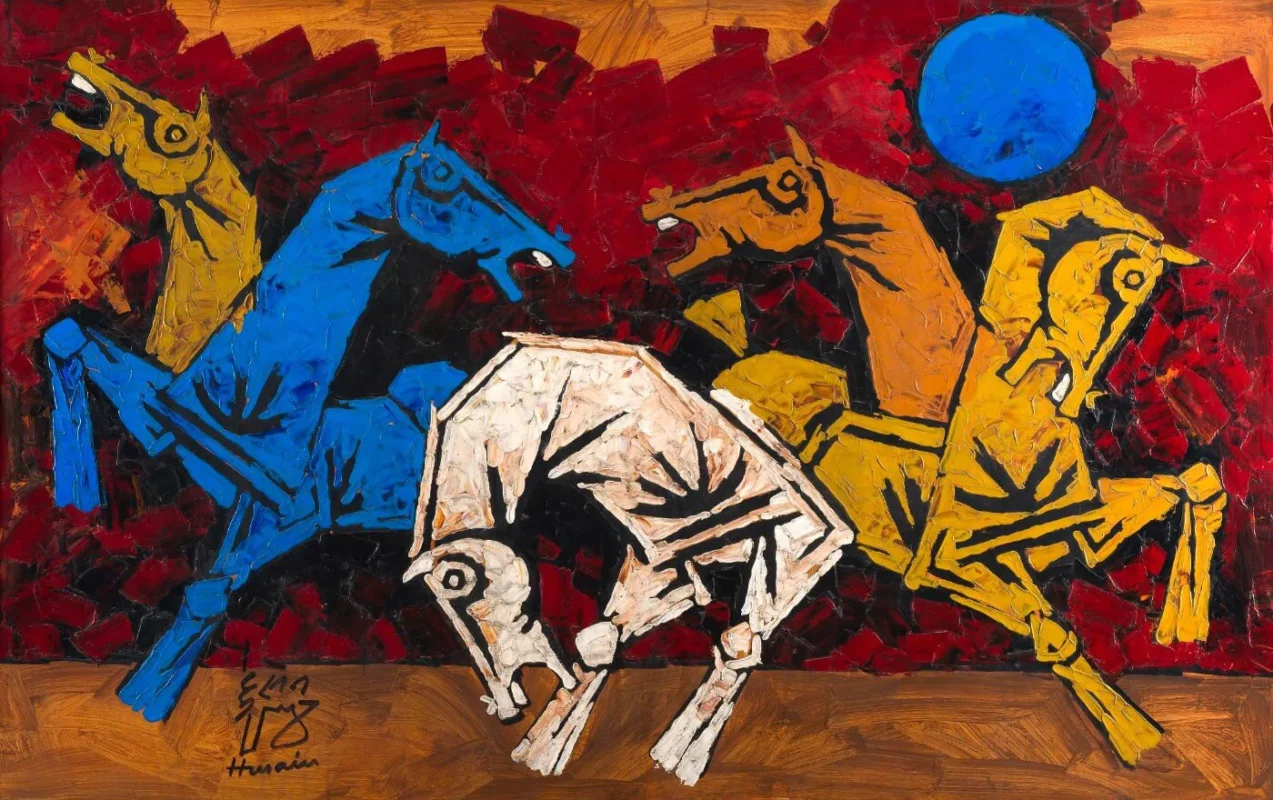Indian Art
10 Most Famous Indian Paintings that You Should Know About
Indian art is a rich and diverse collection of styles, techniques, and mediums that reflect the country’s vibrant culture and history. From traditional frescoes and murals to contemporary abstracts, Indian art is renowned for its aesthetic beauty and cultural significance.
In this article, we will take a look at ten of the most famous Indian paintings that you should know about. These works represent the diversity of Indian art, showcasing the different styles and techniques used by some of the country’s most renowned artists.
From the bold brushstrokes and vibrant colors of Nandalal Bose’s “Annapurna” to the realism and attention to detail of Raja Ravi Varma’s “Hamsa Damayanti”, these paintings are sure to inspire and captivate.
1. “Annapurna” by Nandalal Bose:

Annapurna is a painting created by Indian artist Nandalal Bose in 1943. The painting depicts the Hindu goddess Annapurna, who is the goddess of food and nourishment. The goddess is shown holding a vessel of food in one hand and a spoon in the other, symbolizing her role as the provider of sustenance for humanity.
Bose’s Annapurna painting is notable for its use of traditional Indian art techniques, such as the use of vibrant colors and the depiction of the goddess in a stylized, symbolic form. The painting is considered an important example of the Bengal School of Art, which was a major artistic movement in India in the early 20th century that sought to revive traditional Indian art forms and promote a sense of national identity.
Overall, Nandalal Bose’s Annapurna painting is considered a significant work of Indian art, both for its representation of the goddess Annapurna and for its use of traditional Indian art techniques.
2. “Bharat Mata” by Abanindranath Tagore:

“Bharat Mata” is a painting created by Indian artist Abanindranath Tagore in 1905, a member of the Tagore family and a prominent figure in the Indian art world. The painting depicts the goddess Bharat Mata, who is a personification of India as a mother figure.
“Bharat Mata” is considered a significant work of Indian art, both for its representation of the goddess Bharat Mata and for its use of traditional Indian art styles. It is also considered a symbol of the Indian nationalist movement, which sought to promote a sense of national identity and pride in India.
Abanindranath Tagore’s Bharat Mata painting is considered a seminal work of Indian art and continues to be widely admired and celebrated today.
3. “Hamsa Damayanti” by Raja Ravi Varma:

“Hamsa Damayanti” is a famous painting by Raja Ravi Varma that was created in 1899. The painting depicts Damayanti, the protagonist and heroine of the Sanskrit epic “Nala and Damayanti”. The story tells of how Damayanti and King Nala fall in love with each other after hearing about each other’s noble traits, intelligence, and beauty. They use a golden swan as a messenger to exchange messages.
The painting showcases Raja Ravi Varma’s artistic skill and his ability to recreate the essence of Indian mythology in his art. His paintings were highly popular in the late 19th and early 20th centuries and continue to be widely admired and appreciated today. “Hamsa Damayanti” is considered one of his most famous and iconic works, and it is a testament to his enduring legacy as a master painter.
4. “Three Pujarins” by Jamini Roy:

“Three Pujarins” is a beautiful painting of Santhal Women created by Jamini Roy, one of the earliest and most significant modernists of Indian art. He was active as an artist between 1887-1972.
“Three Pujarins” is a perfect example of Jamini Roy’s unique style and his ability to capture the essence of Indian folk and tribal art. It depicts three Santhal women dressed in traditional clothes, with simple, yet striking features. The use of vibrant colors and bold lines adds to the striking nature of the painting.
Jamini Roy’s contributions to Indian art were significant as he was one of the first artists to draw inspiration from Indian folk and tribal art and bring it to the mainstream art world. His work continues to be widely admired and appreciated today and has played an important role in the development of modern Indian art.
5. “Three Girls” by Amrita Sher-Gil:

“Three Girls” is a painting by Amrita Sher-Gil, an Indian artist. It was painted in 1935, the first work to be painted by Sher-Gil after returning to India from Europe in 1934. The painting is also sometimes referred to as “Group of Three Girls”.
The painting depicts three young girls in a relaxed and casual pose. It is believed to be a representation of the artist’s own childhood memories and experiences, as the girls depicted in the painting are believed to be from the artist’s own family. The girls are shown sitting on a terrace, dressed in traditional Indian clothes, and with the background of a small village.
“Three Girls” is considered a significant painting in the artist’s oeuvre, as it marked her return to India and her renewed engagement with her Indian heritage and identity. The painting is known for its bold and expressive brushstrokes, bright colors, and the use of light and shadow to create a sense of depth and realism.
The painting won the Gold Medal at the annual exhibition of the Bombay Art Society in 1937, a testament to its quality and impact. Today, it is considered one of Amrita Sher-Gil’s most iconic works and continues to be widely admired and appreciated.
6. “Five Horses” by MF Husain:

“Five Horses” is a famous painting by M.F. Husain, a renowned Indian artist. The image of the horse has always remained a powerful motif in M.F. Husain’s expansive oeuvre. In Indian mythology, the horse is revered as a symbol of the sun, of power, knowledge, and fertility. Similarly, Husain’s horses are always depicted as strong and free-willed creatures, worthy of all their mythical and ritualistic symbolism.
“Five Horses” is a painting that features five horses, each one in a different pose, and with different expressions. The horses are shown in a dynamic and fluid composition, with their bodies twisted and turned in different directions, giving the impression of movement and energy. The use of bold, bright colors adds to the sense of movement and dynamism in the painting.
The painting is considered one of M.F. Husain’s most iconic works, and it showcases his ability to capture the essence of the horse in his art. He was able to portray the horse’s grace, power and beauty in his paintings. His work continues to be widely admired and appreciated today and has played an important role in the development of modern Indian art.
7. “Untold Element” by Tyeb Mehta:

“Untold Element” is a painting by Tyeb Mehta, an Indian painter who was considered one of the most important artists of the Indian modernist movement. The painting was created in 1985.
The painting depicts a group of figures, which are seemingly in motion. The figures are elongated and distorted, giving an impression of movement and energy. The use of bold and contrasting colors adds to the sense of movement and dynamism in the painting. The figures are depicted in a minimalist and abstract style, which gives the painting a sense of ambiguity and complexity.
Mehta’s painting is known for its ability to capture the essence of human emotions and experiences in a bold and powerful way. His work is often thought to be a reflection of the social and political climate of India during his time, and it is considered a powerful commentary on the human condition. “Untold Element” is considered one of Tyeb Mehta’s most iconic works and continues to be widely admired and appreciated today. The painting represents Mehta’s ability to capture the essence of human emotions and experiences in a bold and powerful way and it’s considered a powerful commentary on the human condition.
8. “Dancing Women” by Rabindranath Tagore:

“Dancing Women” is a painting by Rabindranath Tagore, an Indian polymath who was a painter, writer, philosopher, and the first non-European to win the Nobel Prize in Literature in 1913. The painting was created during Tagore’s artistic period, which was between 1883-1940. The painting is considered one of Tagore’s most iconic works, and it showcases his ability to capture the essence of the movement and grace of the female form.
The painting depicts of women dancing, with their bodies twisted and turned in different directions, giving the impression of movement and energy. The use of bold, bright colors adds to the sense of movement and dynamism in the painting.
The painting is considered an excellent example of Tagore’s artistic skill and his ability to capture the essence of Indian culture and tradition in his art. His work continues to be widely admired and appreciated today and has played an important role in the development of modern Indian art. “Dancing Women” is a beautiful and powerful painting that showcases Rabindranath Tagore’s artistic skills and his ability to capture the essence of Indian culture and tradition in his art.
9. “Saurashtra” by SH Raza:

“Saurashtra” is a painting by S.H. Raza, an Indian painter known for his contribution to the Progressive Artists’ Group, which aimed to modernize Indian art in the 1940s and 1950s. The painting was created in 1983.
The painting depicts an abstract composition of geometric shapes, lines, and colors. The use of bright, warm colors, such as red, orange, and yellow, gives the painting a sense of energy and movement. The painting is a non-figurative representation of the Saurashtra region of Gujarat, India, which is known for its rich cultural heritage and history. The painting is thought to be an interpretation of Raza’s memories and emotions associated with the region.
Raza’s painting is known for its ability to capture the essence of Indian culture and tradition in an abstract form. His work is often thought to be a reflection of the cultural and spiritual influences of India, and it is considered a powerful commentary on the human condition. “Saurashtra” is considered one of S.H. Raza’s most iconic works and continues to be widely admired and appreciated today. The painting represents Raza’s ability to capture the essence of Indian culture and tradition in an abstract form and it’s considered a powerful commentary on the human condition.
10. “Untitled Canvas Painting” by Vasudeo S Gaitonde

An untitled oil on canvas painting by Vasudeo S Gaitonde, one of India’s most renowned abstract painters, was sold for a record-breaking USD 4,415,008 (Rs 29.3 crore) at a Christie’s auction in New York in September 2015. This made it the most expensive Indian artwork to be sold since 1965.
Gaitonde’s work is known for its unique style, which combines elements of abstract expressionism with Indian spiritual and philosophical concepts. His paintings are characterized by their use of bold and bright colors, as well as their layered, textured surfaces. This untitled painting by Gaitonde is particularly notable for its striking composition, with its bold and sweeping brushstrokes and its use of a monochromatic color palette.
Gaitonde’s painting has been widely admired and appreciated for its unique style and powerful visual impact. His work continues to be widely admired and appreciated today and has played an important role in the development of modern Indian art. This untitled painting by Gaitonde is considered one of his most iconic works and continues to be widely admired and appreciated today, becoming a reference in Indian art history.
Conclusion:
In conclusion, Indian art and paintings have a rich cultural heritage that is reflected in the works of many famous Indian artists. The ten paintings discussed in this article are just a small representation of the vast and diverse collection of Indian art.
Each painting is unique in its own way and they are all worth studying and appreciating for the beauty and meaning they convey. From the iconic “The Dance of Shiva” to the realistic “Gaja-Lakshmi,” these paintings showcase the diversity and richness of Indian art.
They are a testament to the skill and creativity of Indian artists and their ability to capture the essence of Indian culture and tradition in their works. We hope this article has inspired you to learn more about Indian art and paintings.

